|
My
father took me to the cinema as a young boy and I marveled at
this incredible story, which I later learned was based on a true
story about a whale sinking a commercial whaling ship. Gregory Peck gives a superb
performance as Captain Ahab. It broke my heart when I found out
that Herbert Melville bankrupt himself publishing this work,
having made sufficient to retire on - and ended his days working
as a night watchman.
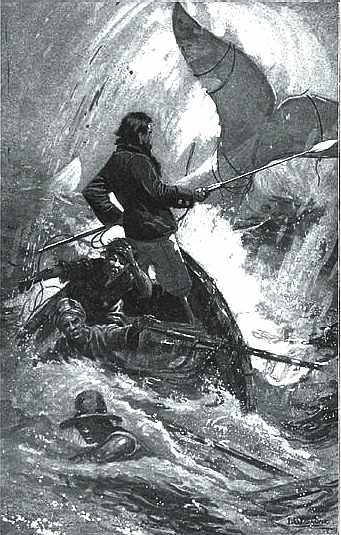
Moby
Dick, the final chase, a classic scene
'Moby-Dick'; or, 'The Whale' is a novel by Herman Melville, first published in
1851. It is considered to be one of the Great American Novels and a treasure of world literature. The story tells the adventures of wandering sailor Ishmael, and his voyage on the whaleship Pequod, commanded by Captain Ahab. Ishmael soon learns that Ahab has one purpose on this voyage: to seek out Moby Dick, a ferocious, enigmatic white sperm whale. In a previous encounter, the whale destroyed Ahab's boat and bit off his leg, which now drives Ahab to take revenge.
In Moby-Dick, Melville employs stylized language, symbolism, and the metaphor to explore numerous complex themes. Through the journey of the main characters, the concepts of class and social status, good and evil, and the existence of God are all examined, as the main characters speculate upon their personal beliefs and their places in the universe. The narrator's reflections, along with his descriptions of a sailor's life aboard a whaling ship, are woven into the narrative along with Shakespearean literary devices, such as stage directions, extended soliloquies, and asides. The book portrays destructive obsession and monomania, as well as the assumption of
anthropomorphism - projecting human instincts, characteristics and motivations onto animals. Moby Dick is ruthless in attacking the sailors who attempt to hunt and kill him, but it is Ahab who invests Moby Dick's natural instincts with malignant and evil intentions. In fact, it is not the whale but the crippled Ahab who alone possesses this characteristic.
Moby-Dick has been classified as American Romanticism. It was first published by Richard Bentley in London on October 18, 1851, in an expurgated three-volume edition titled The Whale, and weeks later as a single volume, by New York City publisher Harper and Brothers as Moby-Dick; or, The Whale on November 14, 1851. The book initially received mixed reviews, but Moby-Dick is now considered part of the Western
canon, and at the center of the canon of American novels.
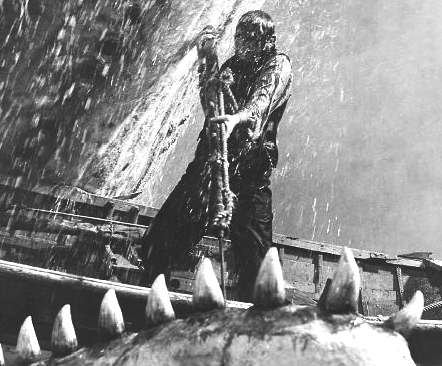
Captain
Ahab harpoons Moby Dick's mouth
Background
Moby-Dick was published in 1851 during a productive time in American literature, which also saw the appearance of Nathaniel Hawthorne's The Scarlet Letter and Harriet Beecher Stowe's Uncle Tom's Cabin. Two actual events served as the genesis for Melville's tale. One was the sinking of the Nantucket ship Essex in 1820, after it was rammed by a large sperm whale 2,000 miles (3,200 km) from the western coast of South
America. First mate Owen Chase, one of eight survivors, recorded the events in his 1821 Narrative of the Most Extraordinary and Distressing Shipwreck of the Whale-Ship Essex.
The other event was the alleged killing in the late 1830s of the albino sperm whale Mocha Dick, in the waters off the Chilean island of Mocha. Mocha Dick was rumored to have twenty or so harpoons in his back from other whalers, and appeared to attack ships with premeditated ferocity. One of his battles with a whaler served as subject for an article by explorer Jeremiah N.
Reynolds in the May 1839 issue of The Knickerbocker or New-York Monthly Magazine. Melville was familiar with the article, which described:
This renowned monster, who had come off victorious in a hundred fights with his pursuers, was an old bull whale, of prodigious size and strength. From the effect of age, or more probably from a freak of nature... a singular consequence had resulted - he was white as
wool!
Significantly, Reynolds writes a first-person narration that serves as a frame for the story of a whaling captain he meets. The captain resembles Ahab and suggests a similar symbolism and single-minded motivation in hunting this whale, in that when his crew first encounters Mocha Dick and cowers from him, the captain rallies them:
As he drew near, with his long curved back looming occasionally above the surface of the billows, we perceived that it was white as the surf around him; and the men stared aghast at each other, as they uttered, in a suppressed tone, the terrible name of MOCHA DICK! "Mocha Dick or the d----l [devil],' said I, 'this boat never sheers off from any thing that wears the shape of a
whale."
Mocha Dick had over 100 encounters with whalers in the decades between 1810 and the 1830s. He was described as being gigantic and covered in barnacles. Although he was the most famous, Mocha Dick was not the only white whale in the
sea, nor the only whale to attack hunters. While an accidental collision with a sperm whale at night accounted for sinking of the Union in
1807, it was not until August 1851 that the whaler Ann Alexander, while hunting in the Pacific off the Galapagos Islands, became the second vessel since the Essex to be attacked, holed and sunk by a whale. Meville remarked:
Ye Gods! What a commentator is this Ann Alexander whale. What he has to say is short & pithy & very much to the point. I wonder if my evil art has raised this
monster.
While Melville had already drawn on his different sailing experiences in his previous novels, such as Mardi, he had never focused specifically on whaling. The eighteen months he spent as an ordinary seaman aboard the whaler Acushnet in 1841-42, and on one incident in particular, now served as inspiration. It was during a mid-ocean "gam" (rendezvous at sea between ships) that he met Chase's son William, who loaned him his father's book. Melville later wrote:
I questioned him concerning his father's adventure; . . . he went to his chest & handed me a complete copy . . . of the Narrative [of the Essex catastrophe]. This was the first printed account of it I had ever seen. The reading of this wondrous story on the landless sea, and so close to the very latitude of the shipwreck, had a surprising effect upon
me.
The book was out of print, and rare. Knowing that Melville was looking for it, his father-in-law, Lemuel Shaw, managed to find a copy and buy it for him. When Melville received it, he fell to it almost immediately, heavily annotating
it.
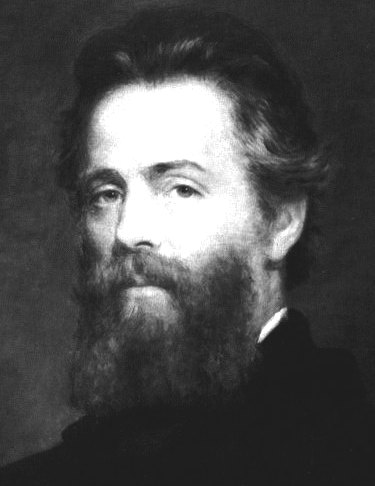
Herman
Melville
Herman Melville
Moby-Dick contains large sections—most of them narrated by Ishmael—that seemingly have nothing to do with the plot but describe aspects of the whaling business. Although there had been a successful earlier novel about Nantucket whalers, Miriam Coffin or The Whale-Fisherman (1835) by Joseph C.
Hart., which is credited with influencing elements of Melville's work, most accounts of whaling tended to be sensational tales of bloody mutiny, and Melville believed that no book up to that time had portrayed the whaling industry in as fascinating or immediate a way as he had experienced it. Early Romantics also proposed that fiction was the exemplary way to describe and record history, so Melville wanted to craft something educational and definitive. Despite his own interest in the subject, Melville struggled with composition, writing to Richard Henry Dana, Jr. on May 1, 1850:
I am half way in the work ... It will be a strange sort of book, tho', I fear; blubber is blubber you know; tho' you might get oil out of it, the poetry runs as hard as sap from a frozen maple tree; — and to cook the thing up, one must needs throw in a little fancy, which from the nature of the thing, must be ungainly as the gambols of the whales themselves. Yet I mean to give the truth of the thing, spite of
this.
There are scholarly theories that purport a literary legend of two Moby-Dick tales, one being a whaling tale as was Melville's experience and affinity, and another deeper tale, inspired by his literary friendship with and respect for Nathaniel Hawthorne. These merged into the latter, the morality
tale. Hawthorne and his family had moved to a small red farmhouse near Lenox, Massachusetts, at the end of March
1850. He became friends with Oliver Wendell Holmes, Sr. and Herman Melville beginning on August 5, 1850, when the authors met at a picnic hosted by a mutual
friend. Melville had just read Hawthorne's short story collection Mosses from an Old Manse, and his unsigned review of the collection, titled "Hawthorne and His Mosses", was printed in the The Literary World on August 17 and
24. Melville wrote that these stories revealed a dark side to Hawthorne, "shrouded in blackness, ten times
black"., and dedicated Moby-Dick to him:
In token of my admiration for his genius, this book is inscribed to Nathaniel
Hawthorne.
Plot
Voyage of the Pequod (illustrated by Everett Henry)."Call me Ishmael," Moby-Dick begins, in one of the most recognizable opening lines in Western
literature. The narrator, an observant young man setting out from Manhattan, has experience in the merchant marine but has recently decided his next voyage will be on a whaling ship. On a cold, gloomy night in December, he arrives at the Spouter-Inn in New Bedford, Massachusetts, and agrees to share a bed with a then-absent stranger. When his bunk mate, a heavily tattooed Polynesian harpooner named Queequeg, returns very late and discovers Ishmael beneath his covers, both men are alarmed, but the two quickly become close friends and decide to sail together from Nantucket, Massachusetts on a whaling voyage.
In Nantucket, the pair signs on with the Pequod, a whaling ship that is soon to leave port. The ship’s captain, Ahab, is nowhere to be seen; nevertheless, they are told of him — a "grand, ungodly, godlike
man," who has "been in colleges as well as 'mong the cannibals," according to one of the owners. The two friends encounter a mysterious man named Elijah on the dock after they sign their papers and he hints at troubles to come with Ahab. The mystery grows on Christmas morning when Ishmael spots dark figures in the mist, apparently boarding the Pequod shortly before it sets sail that day.
The ship’s officers direct the early voyage while Ahab stays in his cabin. The chief mate is Starbuck, a serious, sincere Quaker and fine leader; second mate is Stubb, happy-go-lucky and cheerful and always smoking his pipe; the third mate is Flask, short and stout but thoroughly reliable. Each mate is responsible for a whaling boat, and each whaling boat of the Pequod has its own pagan harpooneer assigned to it. Some time after sailing, Ahab finally appears on the quarter-deck one morning, an imposing, frightening figure whose haunted visage sends shivers over the narrator. One of his legs is missing from the knee down and has been replaced by a prosthesis fashioned from a sperm whale's jawbone.
He looked like a man cut away from the stake, when the fire has overrunningly wasted all the limbs without consuming them, or taking away one particle from their compacted aged robustness... Threading its way out from among his grey hairs, and continuing right down one side of his tawny scorched face and neck, till it disappeared in his clothing, you saw a slender rod-like mark, lividly whitish. It resembled that perpendicular seam sometimes made in the straight, lofty trunk of a great tree, when the upper lightning tearingly darts down it, and without wrenching a single twig, peels and grooves out the bark from top to bottom ere running off into the soil, leaving the tree still greenly alive, but branded.
— Moby-Dick, Ch. 28
Soon gathering the crewmen together, with a rousing speech Ahab secures their support for his single, secret purpose for this voyage: hunting down and killing Moby Dick, an old, very large sperm whale, with a snow-white hump and mottled skin, that crippled Ahab on his last whaling voyage. Only Starbuck shows any sign of resistance to the charismatic but monomaniacal captain. The first mate argues repeatedly that the ship’s purpose should be to hunt whales for their oil, with luck returning home profitably, safely, and quickly, but not to seek out and kill Moby Dick in particular — and especially not for revenge. Eventually even Starbuck acquiesces to Ahab's will, though harboring misgivings.
The mystery of the dark figures seen before the Pequod set sail is explained during the voyage's first lowering for whales. Ahab has secretly brought along his own boat crew, including a mysterious harpooneer named Fedallah (also referred to as 'the Parsee'), an inscrutable figure with a sinister influence over Ahab. Later, while watching one night over a captured whale carcass, Fedallah gives dark prophecies to Ahab regarding their twin deaths.
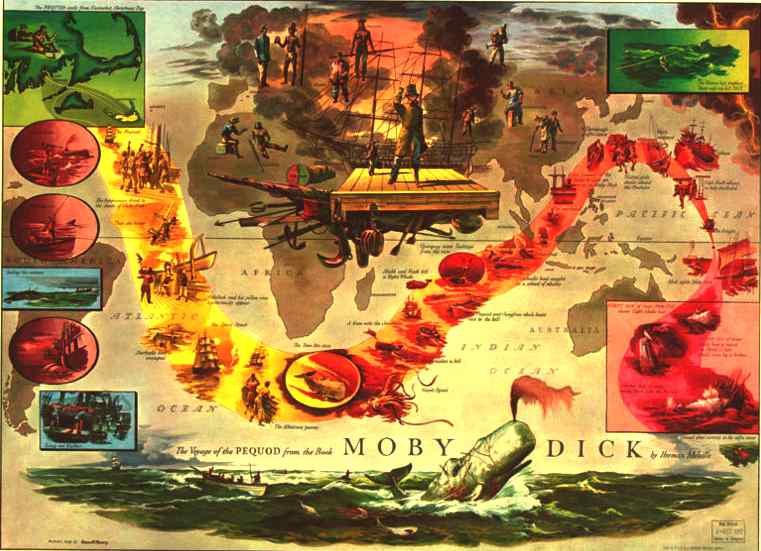
Terrific
montage world map of the Pequad's voyage
Moby Dick
The novel describes numerous "gams," social meetings of two ships on the open sea. Crews normally visit each other during a gam, captains on one vessel and chief mates on the other. Mail may be exchanged and the men talk of whale sightings or other news. For Ahab, however, there is but one relevant question to ask of another ship: “Hast seen the White Whale?” After meeting several other whaling ships, which have their own peculiar stories, the Pequod enters the Pacific Ocean. Queequeg becomes deathly ill and requests that a coffin be built for him by the ship’s carpenter. Just as everyone has given up hope, Queequeg changes his mind, deciding to live after all, and recovers quickly. His coffin becomes his sea chest, and is later caulked and pitched to replace the Pequod's life buoy.
Soon word is heard from other whalers of Moby Dick. The jolly Captain Boomer of the Samuel Enderby has lost an arm to the whale, and is stunned at Ahab's burning need for revenge. Next they meet the Rachel, which has seen Moby Dick very recently. As a result of the encounter, one of its boats is missing; the captain’s youngest son had been aboard. The Rachel's captain begs Ahab to aid in the search for the missing boat, but Ahab is resolute; the Pequod is very near the White Whale now and will not stop to help. Finally the Delight is met, even as its captain buries a sailor who had been killed by Moby Dick. Starbuck begs Ahab one final time to reconsider his thirst for vengeance, but to no avail.
The next day, the Pequod meets Moby Dick. For two days, the Pequod's crew pursues the whale, which wreaks widespread destruction, including the disappearance of Fedallah. On the third day, Moby Dick rises up to reveal Fedallah tied to him by harpoon ropes, clearly dead. Even after the initial battle on the third day, it is clear that while Ahab is a vengeful whale-hunter, Moby Dick, while dangerous and fearless, is not motivated to hunt humans. As he swims away from the Pequod, Starbuck exhorts Ahab one last time to desist, observing that:
"Moby Dick seeks thee not. It is thou, thou, that madly seekest him!".
— Moby-Dick, Ch. 135
Ahab ignores this voice of reason and continues with his ill-fated chase. As the three boats sail out to hunt him, Moby Dick damages two of them, forcing them to go back to the ship and leaving only Ahab's vessel intact. Ahab harpoons the whale, but the harpoon-line breaks. Moby Dick then rams the Pequod itself, which begins to sink. As Ahab harpoons the whale again, the unfolding harpoon-line catches him around his neck and he is dragged into the depths of the sea by the diving Moby Dick. The boat is caught up in the whirlpool of the sinking ship, which takes almost all the crew to their deaths. Only Ishmael survives, clinging to Queequeg’s coffin-turned-life buoy for an entire day and night before the Rachel rescues him.
Characters
The crew-members of the Pequod are carefully drawn stylizations of human types and habits; critics have often described the crew as a "self-enclosed universe". There are 30 crew members, and as there were thirty states in the union at the time, it has been suggested that, in its diversity, Melville meant the Pequod to be a metaphor for America.
Ishmael
The name has come to symbolize orphans, exiles, and social outcasts — in the opening paragraph of Moby-Dick, Ishmael tells the reader that he has turned to the sea out of a feeling of alienation from human society. In the last line of the book, Ishmael also refers to himself symbolically as an orphan, which maintains the Biblical connection and emphasises the representation of outcasts. In the Book of Genesis, Ishmael is the son born to Abraham and his wife's maidservant, Hagar, whom his barren wife, Sarah, gives to her husband so he may have a son. When Sarah finally bears a son of her own, Isaac, out of fear and jealousy she has Abraham exile Hagar and Ishmael into the desert (Genesis 21:10).
Ishmael has a rich literary background (he has previously been a schoolteacher), which he brings to bear on his shipmates and events that occur while at sea. His assurance that "only I alone escaped to tell you" (tell thee) is the messenger's admonishment in Job 1: 15-17, 19.
Elijah
The character Elijah (named for the Biblical prophet Elijah, who is also referred to in the King James Bible as Elias), on learning that Ishmael and Queequeg have signed onto Ahab's ship, asks, "Anything down there about your souls?" When Ishmael reacts with surprise, Elijah continues:
Oh, perhaps you hav'n't got any," he said quickly. "No matter though, I know many chaps that hav'n't got any — good luck to 'em; and they are all the better off for it. A soul's a sort of a fifth wheel to a wagon."
— Moby-Dick, Ch. 19
Later in the conversation, Elijah adds:
Well, well, what's signed, is signed; and what's to be, will be; and then again, perhaps it wont be, after all. Any how, it's all fixed and arranged a'ready; and some sailors or other must go with him, I suppose; as well these as any other men, God pity 'em! Morning to ye, shipmates, morning; the ineffable heavens bless ye; I'm sorry I stopped ye.
— Moby-Dick, Ch. 19

Gregory
Peck as Captain Ahab
Ahab
Ahab is the tyrannical captain of the Pequod who is driven by a monomaniacal desire to kill Moby Dick, the whale that had maimed him off the coast of Japan[29] during a previous whaling voyage. Although he is a Quaker, he seeks revenge in defiance of his religion's well-known pacifism. Ahab's Biblical namesake is the evil idol-worshipping ruler in the Book of Kings, and this association prompts Ishmael to ask, at his first encounter with Ahab:
"When that wicked king was slain, the dogs, did they not lick his blood?".
— Moby-Dick, Ch. 16
When Ishmael remarks upon the ill associations of such a name, he is rebuked by one of Ahab's colleagues, who points out that "He did not name himself!"
Little information is provided about Ahab's life prior to meeting Moby Dick, although it is known that he was orphaned at a young age. When discussing the purpose of his quest with Starbuck, it is revealed that he first began whaling at eighteen and has continued in the trade for forty years making him 58 years of
age and having spent less than three on land. He also mentions his "girl-wife," whom he married late in life, and their young son, but does not give their names.
Ahab ultimately dooms the crew of the Pequod (save for Ishmael) to death by his obsession with Moby Dick. During the final chase, Ahab hurls his last harpoon while yelling his now-famous revenge line:
... to the last I grapple with thee; from hell's heart I stab at thee; for hate's sake I spit my last breath at thee.
— Moby-Dick, Ch. 135
The harpoon becomes lodged in Moby Dick's flesh and Ahab, caught around the neck by a loop in his own harpoon's rope and unable to free himself, is dragged down into the cold oblivion of the sea by the injured whale. The mechanics of Ahab's death are richly symbolic. He is killed by his own harpoon, a victim of his own twisted obsession and desire for revenge. The whale eventually destroys the whaleboats and crew, and sinks the Pequod.
Ahab's motivation for hunting Moby Dick is explored in the following passage:
The White Whale swam before him as the monomaniac incarnation of all those malicious agencies which some deep men feel eating in them, till they are left living on with half a heart and half a lung. That intangible malignity which has been from the beginning; to whose dominion even the modern Christians ascribe one-half of the worlds; which the ancient Ophites of the east reverenced in their statue devil; -- Ahab did not fall down and worship it like them; but deliriously transferring its idea to the abhorred white whale, he pitted himself, all mutilated, against it. All that most maddens and torments; all that stirs up the lees of things; all truth with malice in it; all that cracks the sinews and cakes the brain; all the subtle demonisms of life and thought; all evil, to crazy Ahab, were visibly personified, and made practically assailable in Moby Dick. He piled upon the whale's white hump the sum of all the general rage and hate felt by his whole race from Adam down; and then, as if his chest had been a mortar, he burst his hot heart's shell upon it.
— Moby-Dick, Ch. 41
Captain
Boomer
Captain of the Samuel Enderby of London, Ahab encounters him at sea. Boomer has not only seen Moby Dick recently, but lost his arm to him in a previous attack. Like Ahab, he has replaced the missing limb with a prosthesis made of sperm whale bone. Ahab immediately assumes he has found a kindred spirit in his thirst for vengeance, but Boomer is yet another representation of the duality to be found throughout the novel; in this instance, a sane and rational counterpart to Ahab. While Boomer also anthropormorphizes Moby Dick, describing the "boiling rage" the whale seemed to be in when Boomer attempted to capture him, he has easily come to terms with losing his arm, and harbors no ill-will against Moby Dick, advising Ahab "he's best left alone". The Enderby's doctor provides solid reasoning for this attitude, informing the gathering:
Do you know, gentlemen, that the digestive organs of the whale are so inscrutably constructed by Divine Providence, that it is quite impossible for him to completely digest even a man's arm? And he knows it too. So that what you take for the White Whale's malice is only his awkwardness. For he never means to swallow a single limb; he only thinks to terrify by feints..
— Moby-Dick, Ch. 100
Boomer jokingly tells a long yarn about the loss of his arm; this attitude, coupled with a lack of urgency in telling where he sighted Moby Dick, infuriates Ahab, leading Boomer to query, "Is your captain crazy?" Ahab immediately quits the Enderby and is so hasty in his return to the Pequod that he cracks and splinters his whalebone leg, then further damages it in admonishing the helmsman. While appearing to be whole, the leg is badly damaged and cannot be trusted; it now serves as metaphor for its wearer.
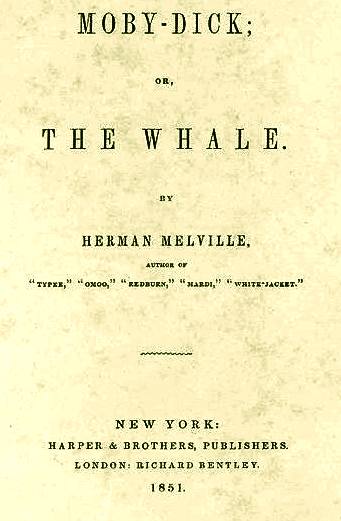
Moby
Dick
He is a giant albino
sperm whale and the main antagonist of the novel. He bit off Ahab's leg, leaving Ahab to swear revenge. The cetacean also attacked the Rachel and killed the captain's son. At the end of the story he kills the entire crew of the Pequod, with the exception of Ishmael. The story does not tell whether or not he survives his own wounds after that. Although he is an integral part of the novel, Moby Dick appears in just three of the 135 chapters and the reader does not have access to his thoughts and motivations. Moby Dick is considered to be a symbol of a number of things, among them God, nature, fate, the ocean, and the very universe itself.
The symbolism of the White Whale is deliberately enigmatic, and its inscrutability is a deliberate challenge to the reader. Ishmael describes the whale’s forehead as having wrinkles and scars on it that look like hieroglyphics, and recounts:
If then, Sir William Jones, who read in thirty languages, could not read the simplest peasant’s face in its profounder and more subtle meanings, how may unlettered Ishmael hope to read the awful Chaldee of the Sperm Whale’s brow? I put that brow before you. Read it if you can.
— Moby-Dick, Ch. 79
All the reader can know is that the White Whale symbolizes many things to various characters in the novel. It is their personal interpretations of Moby-Dick, in addition to their individual ruminations on the gold doubloon Ahab has nailed to the mast to motivate his crew, that serve as a further clue to their own inner makeup.
Mates
The three mates of the Pequod are all from New England.
Starbuck
Starbuck, the young chief mate of the Pequod, is a thoughtful and intellectual Quaker from Nantucket.
Uncommonly conscientious for a seaman, and endued with a deep natural reverence, the wild watery loneliness of his life did therefore strongly incline him to superstition; but to that sort of superstition, which in some organization seems rather to spring, somehow, from intelligence than from ignorance... [H]is far-away domestic memories of his young Cape wife and child, tend[ed] to bend him ... from the original ruggedness of his nature, and open him still further to those latent influences which, in some honest-hearted men, restrain the gush of dare-devil daring, so often evinced by others in the more perilous vicissitudes of the fishery. "I will have no man in my boat," said Starbuck, "who is not afraid of a whale." By this, he seemed to mean, not only that the most reliable and useful courage was that which arises from the fair estimation of the encountered peril, but that an utterly fearless man is a far more dangerous comrade than a coward.
—Moby-Dick, Ch. 26
Little is said about Starbuck's early life, except that he is married with a son. Unlike Ahab's wife, who remains nameless, Starbuck gives his wife's name as Mary. Such is his desire to return to them, that when nearly reaching the last leg of their quest for Moby Dick, he considers arresting or even killing Ahab with a loaded musket, one of several kept by Ahab (in a previous chapter Ahab threatens Starbuck with one when Starbuck disobeys him, despite Starbuck's being in the right), and turning the ship back, straight for home.
Starbuck is alone among the crew in objecting to Ahab's quest, declaring it madness to want revenge on an animal, which lacks reason. Starbuck advocates continuing the more mundane pursuit of whales for their oil. But he lacks the support of the crew in his opposition to Ahab, and is unable to persuade them to turn back. Despite his misgivings, he feels himself bound by his obligations to obey the captain.
Starbuck was an important Quaker family name on Nantucket Island, and there were several actual whalemen of this period named "Starbuck," as evidenced by the name of Starbuck Island in the South Pacific whaling grounds. The multinational coffee chain Starbucks was named after Starbuck, not due to any affinity for coffee, but because the name "Pequod" was first rejected by one of the co-founders.
Stubb
Stubb, the second mate of the Pequod, is from Cape Cod, and always seems to have a pipe in his mouth and a smile on his face. "Good-humored, easy, and careless, he presided over his whaleboat as if the most deadly encounter were but a dinner, and his crew all invited guests." (Moby-Dick, Ch. 27) Although he is not an educated man, Stubb is remarkably articulate, and during whale hunts keeps up an imaginative patter reminiscent of that of some characters in Shakespeare. Scholarly portrayals range from that of an optimistic simpleton to a paragon of lived philosophic
wisdom.
Flask
Flask is the third mate of the Pequod. He is from Martha's Vineyard.
King Post is his nickname because he is a short, stout, ruddy young fellow, very pugnacious concerning whales, who somehow seemed to think that the great Leviathans had personally and hereditarily affronted him; and therefore it was a sort of point of honor with him, to destroy them whenever encountered.
— Moby-Dick, Ch. 27
Harpooneers
The harpooneers of the Pequod are all non-Christians from various parts of the world. Each serves on a mate's boat.
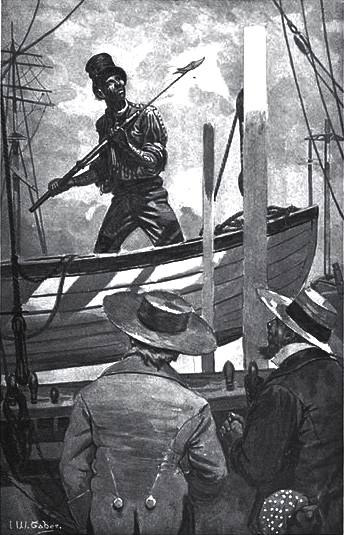
Queequeg
the outrageous harpooneer
Queequeg
Queequeg hails from the fictional island of Kokovoko in the South Seas, inhabited by a cannibal tribe, and is the son of the chief of his tribe. Since leaving the island, he has become extremely skilled with the harpoon. He befriends Ishmael very early in the novel, when they meet in New Bedford, Massachusetts before leaving for Nantucket. He is described as existing in a state between civilized and savage. For example, Ishmael recounts with amusement how Queequeg feels it necessary to hide himself when pulling on his boots, noting that if he were a savage he wouldn't consider boots necessary, but if he were completely civilized he would realize there was no need to be modest when pulling on his boots.
Queequeg is the harpooneer on Starbuck's boat, where Ishmael is also an oarsman. Queequeg is best friends with Ishmael in the story. He is prominent early in the novel, but later fades in significance, as does Ishmael.
Tashtego
Tashtego is described as a Gay Head (Wampanoag) Native American harpooneer. The personification of the hunter, he turns from hunting land animals to hunting whales. Tashtego is the harpooneer on Stubb's boat.
Next was Tashtego, an unmixed Indian from Gay Head, the most westerly promontory of Martha’s Vineyard, where there still exists the last remnant of a village of red men, which has long supplied the neighboring island of Nantucket with many of her most daring harpooneers. In the fishery, they usually go by the generic name of Gay-Headers.
— Moby-Dick, Ch.27
Daggoo
Daggoo is a gigantic (6'5") African harpooneer from a coastal village with a noble bearing and grace. He is the harpooneer on Flask's boat.
Fedallah
Fedallah is the harpooneer on Ahab's boat. He is of Persian Zoroastrian ("Parsi") descent. He is described as having lived in China. At the time when the Pequod sets sail, Fedallah is hidden on board, and he emerges with Ahab's boat's crew later on, to the surprise of the crew. Fedallah is referred to in the text as Ahab's "Dark Shadow." Ishmael calls him a "fire worshipper" and the crew speculates that he is a devil in man's disguise. He is the source of a variety of prophecies regarding Ahab and his hunt for Moby Dick. Ishmael describes him thus, standing by Ahab's boat:
The figure that now stood by its bows was tall and swart, with one white tooth evilly protruding from its steel-like lips. A rumpled Chinese jacket of black cotton funereally invested him, with wide black trowsers of the same dark stuff. But strangely crowning this ebonness was a glistening white plaited turban, the living hair braided and coiled round and round upon his head.
—Moby-Dick, Ch.48
|
Moby
Dick 2010
- Youtube
|
Moby
Dick 2011 - Youtube
|
|
Moby
Dick 1956, Gregory Peck - Youtube
|
Herman
Melville- Youtube
|
Other notable
characters
Pip (nicknamed "Pippin," but "Pip" for short) is a black boy from Tolland County, Connecticut, who is "the most insignificant of the Pequod's crew". Because he is physically slight, he is made a ship-keeper, (a sailor who stays aboard the ship while its whaleboats go out). Ishmael contrasts him with the "dull and torpid in his intellects" — and paler and much older — steward Dough-Boy, describing Pip as "over tender-hearted" but "at bottom very bright, with that pleasant, genial, jolly brightness peculiar to his tribe". Ishmael goes so far as to chastise the reader: "Nor smile so, while I write that this little black was brilliant, for even blackness has its brilliancy; behold yon lustrous ebony, panelled in king's
cabinets."
The after-oarsman on Stubb's boat is injured, however, so Pip is temporarily reassigned to Stubb's whaleboat crew. The first time out, Pip jumps from the boat, causing Stubb and Tashtego to lose their already-harpooned whale. Tashtego and the rest of the crew are furious; Stubb chides him "officially" and "unofficially," even raising the specter of slavery: "a whale would sell for thirty times what you would, Pip, in Alabama." The next time a whale is sighted, Pip again jumps overboard and is left stranded in the "awful lonesomeness" of the sea while Stubb's and the others' boats are dragged along by their harpooned whales. By the time he is rescued, he has become (at least to the other sailors) "an idiot," "mad." Ishmael, however, thought Pip had a mystical experience: "So man's insanity is heaven's sense." Pip and his experience are crucial because they serve as foreshadowing, in Ishmael's words, "providing the sometimes madly merry and predestinated craft with a living and ever accompanying prophecy of whatever shattered sequel might prove her own." Pip's madness is full of poetry and eloquence; he is reminiscent of Tom in King
Lear. Ahab later sympathizes with Pip and takes the young boy under his wing.
Dough Boy is the pale, nervous steward of the ship. The Cook (Fleece), Blacksmith (Perth), and Carpenter of the ship are each highlighted in at least one chapter near the end of the book. Fleece, a very old, half-deaf African-American with bad knees, is presented in the chapter "Stubb's Supper" at some length in a dialogue where Stubb good-humoredly takes him to task over how to prepare a variety of dishes from the whale's carcass. Ahab calls on the Carpenter to fashion a new whalebone leg after the one he wears is damaged; later he has Perth forge a special harpoon that he carries into the final confrontation with Moby Dick.
The crew as a whole is exceedingly international, having constituents from both the United States and rest of the world. Chapter 40, "Midnight, Forecastle," highlights, in its stage-play manner (in Shakespearean style), the striking variety in the sailors' origins. A partial list of the speakers includes sailors from the Isle of Man, France, Iceland, the Netherlands, the Azores, Sicily and Malta, China, Denmark, Portugal, India, England, Spain, and Ireland.
Non-fictional content
A large fraction of the book relates to the plot only by supplying background, but was most valuable as information in its own right. Most of this is about whales and whaling. There are few errors in it, but he does say in chapter LXXXV that "the whale has no voice", sadly ruling out the possibilities of humpback whales singing or the sperm and other whales using sonar.
The chapter "The Decanter", Chapter CI in the Modern Library edition, is explicitly the report of "historical research" on the provisions of whaling ships of different nations, with an explanation of what prompted his investigation and speculation on the affect of such quantity of beer and gin on the performance of whaling crews.
Heavy scientific and historical description and analysis is typical of Melville. Typee presaged and probably helped motivate Margaret Mead's Coming of Age in Samoa, a classic of cultural anthropology. The extensive anthropology in Moby Dick is developed in the fictional characters, and therefore is described in another section of this article.
Critical reception
Melville's
expectations
In a letter to Nathaniel Hawthorne written within days of Moby-Dick's American publication, Melville made a number of revealing comments:
... for not one man in five cycles, who is wise, will expect appreciative recognition from his fellows, or any one of them. Appreciation! Recognition! Is Jove appreciated? Why, ever since Adam, who has got to the meaning of his great allegory
- the world? Then we pigmies must be content to have our paper allegories but ill comprehended. I say your appreciation is my glorious
gratuity.
A sense of unspeakable security is in me this moment, on account of your understanding the book. I have written a wicked book, and feel spotless as the lamb. Ineffable sociabilities are in me. I would sit down and dine with you and all the gods in old Rome's Pantheon. It is a strange feeling
- no hopefulness is in it, no despair. Content - that is it; and irresponsibility; but without licentious inclination. I speak now of my profoundest sense of being, not of an incidental
feeling.
You did not care a penny for the book. But, now and then as you read, you understood the pervading thought that impelled the book
- and that you praised. Was it not so? You were archangel enough to despise the imperfect body, and embrace the
soul.
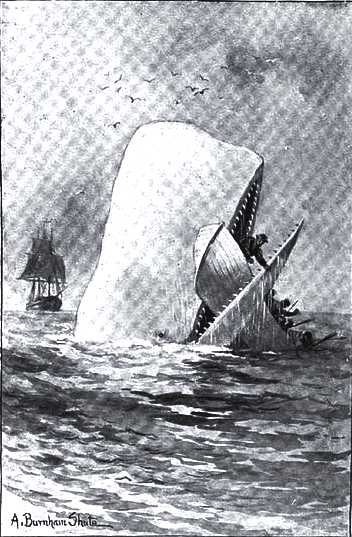
Moby
Dick book illustration, the whale bites her clean in half
Contemporary
Melville was regarded as a very successful author after the acclaim received by his popular earlier works of Typee and Omoo. He considered Moby-Dick to be his magnum opus, but he was shocked and bewildered at the scathing reviews it received. Instead of bringing him the literary acclaim which he sought, this master-work started a slide toward literary obscurity in his lifetime. This was partially due to the fact that the book was first published in England, and the American literary establishment took note of what the English critics said, especially when these critics were attached to the more prestigious journals. Many critics praised it for its unique style, interesting characters, and poetic
language, but others agreed with a critic with the highly regarded London Athenaeum, who described it as:
"[A]n ill-compounded mixture of romance and matter-of-fact. The idea of a connected and collected story has obviously visited and abandoned its writer again and again in the course of composition. The style of his tale is in places disfigured by mad (rather than bad) English; and its catastrophe is hastily, weakly, and obscurely
managed."
One problem was that publisher Peter Bentley botched the English edition, most significantly in omitting the epilogue. For this reason, many of the critics faulted the book, what little they could grasp of it, on purely formal grounds, e.g., how the tale could have been told if no one survived to tell it. The generally bad reviews from across the ocean made American readers skittish about picking up the tome. Still, a handful of American critics saw much more in it than most of their U.S. and English colleagues. Hawthorne said of the book:
"What a book Melville has written! It gives me an idea of much greater power than his preceding
ones".
Another problem was that by the time the book was published, whaling and maritime adventuring were no longer the main focus of the American public. The Gold Rush had shifted their interest to the West, and the lengthy novel, with its long factual passages dealing with the brutal technology of the whaling industry, seemed far less relevant to the author's American audience.
Underground
Within a year after Melville's death, Moby-Dick, along with Typee, Omoo, and Mardi, was reprinted by Harper & Brothers, giving it a chance to be rediscovered. However, only New York's literary underground seemed to take much interest, just enough to keep Melville's name circulating for the next 25 years in the capital of American publishing. During this time, a few critics were willing to devote time, space, and a modicum of praise to Melville and his works, or at least those that could still be fairly easily obtained or remembered. Other works, especially the poetry, went largely
forgotten.
Then came World War I and its consequences, particularly the shaking or destruction of faith in so many aspects of Western civilization, all of which caused people concerned with culture and its potential redemptive value to experiment with new aesthetic techniques. The stage was set for Melville to find his place.
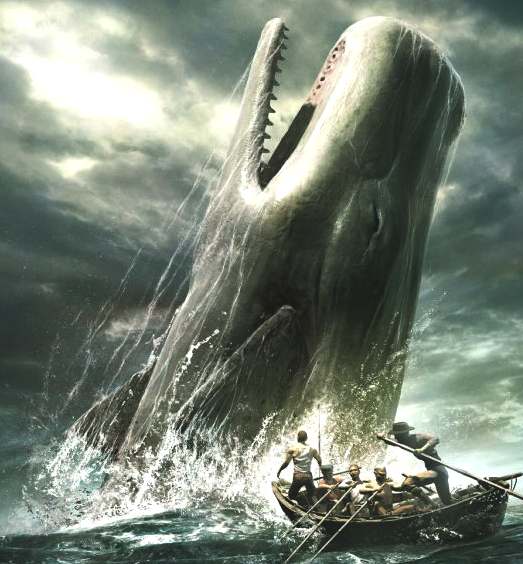
A
great bit of Moby Dick artwork
The Melville
Revival
With the burgeoning of Modernist aesthetics (see Modernism and American modernism) and the war that tore everything apart still so fresh in memory, Moby-Dick began to seem increasingly relevant. Many of Melville's techniques echo those of Modernism: kaleidoscopic, hybrid in genre and tone, monumentally ambitious in trying to unite so many disparate elements and loose ends. His new readers also found in him an almost too-profound exploration of violence, hunger for power, and quixotic goals. Although many critics of this time still considered Moby-Dick extremely difficult to come to grips with, they largely saw this lack of easy understanding as an asset rather than a
liability.
In 1917, American author Carl Van Doren became the first of this period to proselytize about Melville's
value.
In the 1920s, British literary critics began to take notice. In his idiosyncratic but landmark Studies in Classic American Literature, novelist, poet, and short story writer D. H. Lawrence directed Americans' attention to the great originality and value of many American authors, among them Melville. Perhaps most surprising is that Lawrence saw Moby-Dick as a work of the first order despite his using the original English
edition.
In his 1921 study, The American Novel, Carl Van Doren returned to Melville with much more depth. He called Moby-Dick a pinnacle of American
Romanticism.
Post-revival
The next great wave of Moby-Dick appraisal came with the publication of F. O. Matthiessen's American Renaissance: Art and Expression in the Age of Emerson and
Whitman. Published in 1941, the book proposed that Emerson, Whitman, Thoreau, Hawthorne, and Melville were the most prominent figures of a flowering of conflicted (and mostly pre-Civil War) literature important for its promulgation of democracy and the exploration of its possibilities, successes, and failures. Since Matthiessen's book came out shortly before the entry of the U.S. into World War II, critic Nick Selby argues that
… Moby-Dick was now read as a text that reflected the power struggles of a world concerned to uphold democracy, and of a country seeking an identity for itself within that
world.
Adaptations
&
Editions
Melville, H. The Whale. London: Richard Bentley, 1851 3 vols. (viii, 312; iv, 303; iv, 328 pp.) Published October 18, 1851.
Melville, H., Moby-Dick; or, The Whale. New York: Harper and Brothers, 1851. xxiii, 635 pages. Published probably on November 14, 1851.
Melville, H., Moby-Dick; or, The Whale. Chicago: The Lakeside Press, 1930. In three large volumes, encased in a metal slipcase and distinguished by the original, now iconographic woodblock print illustrations of Rockwell Kent. (read about and view them here.)
Melville, H., Moby-Dick; or, The White Whale. Garden City, New York: The Literary Guild of America, 1949. 416 pages. Illustrated by Anton Otto Fischer.
Melville, H. Moby-Dick, or The Whale. Northwestern-Newberry Edition of the Writings of Herman Melville 6. Evanston, Ill.: Northwestern U. Press, 1988. A critical text with appendices on the history and reception of the book. The text is in the public domain.
Melville, H. Moby-Dick, or The Whale Arion Press, San Francisco, 1979, illustrated with 100 wood engravings by Barry Moser. Edition of 265, of which 250 were for sale. One of the most noted fine book editions of 20th century America, recognized by the Grolier Club as one of the 100 most beautiful books of the
century.
Melville, H., Moby Dick; or The Whale. Berkeley, Los Angeles, and London, 1981. A reduced version of the Arion Press Edition with 100 illustrations by Barry Moser.
Melville, H., Moby-Dick or The Whale., 2000, The Modern Library, New York, paper back, introduction by Elizabeth Hardwick, with hundreds of illustrations by Rockwell Kent.
Melville, H., Moby-Dick The Folio Society 2009. A Limited Edition with 281 illustrations by Rockwell Kent.
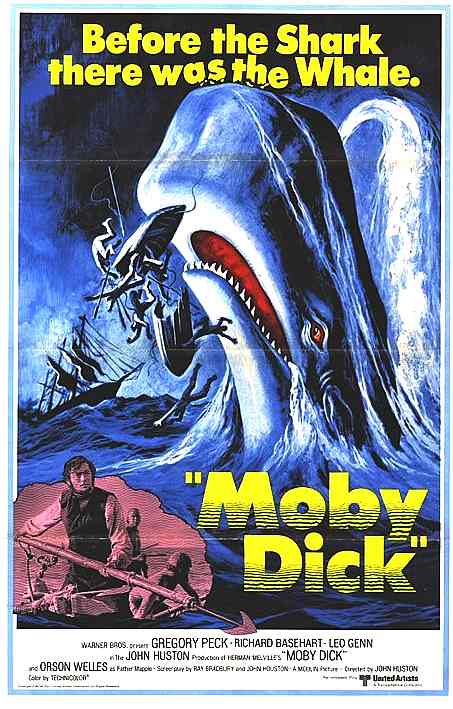
LINKS
and REFERENCE:
Moby-Dick
at Project Gutenberg
The
Sea Beast at the Internet Movie Database
"Into
the Deep: America, Whaling & the World", PBS
Did
Melville Borrow the Idea for 'Moby Dick'? A radio discussion
Moby-Dick
Map.
NOVELIST
INDEX
A - Z
A
- Z FILMS INDEX
A
- Z ACTORS INDEX
|









